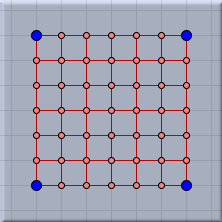Rubber BandRubber Band
Here springconstant is a characteristic constant of the rubber band that can be adjusted in the inspector, and length is the distance between the two points. Thus if two mass-objects are at a certain distance from each other and connected by a rubber band, they will be attracted to each other. Since the attractive force is proportional to the distance of separation, the farther apart the masses are, the stronger the force. If no global friction is present in the Environment, a system of masses and rubber bands will oscillate wildly. The following picture shows the situation of one free mass-point that is connected to a rubber band whose other end is tied to a regular (fixed) geometric point. The curve on the left shows the resulting oscillation of the point. (The curve was generated by the drawcurves(...) operator of CindyScript.)
If one uses the Environment to add some global friction, a damping of the oscillation will occur. In such a case, the system will converge to an equilibrium situation in which it comes to rest. The following picture shows a chain of masses connected by rubber bands under the influence of Gravity.
Networks of rubber bands exhibit interesting behavior. In a sense, such networks behave like spider webs. The following pictures show a gridlike arrangement of masses and rubber bands with various points pinned to the ground plane in the equilibrium situation.
Inspecting and CindyScriptRubber band, Spring, and Coulomb Force are objects that can be transformed one into another. A detailed discussion of the very powerful spring inspector as well as of the CindyScript interface can be found in the documentation to Spring mode.
Contributors to this page: Richter
,
Kortenkamp
,
Kohler
,
Kramer
and
Dietrich
. The content on this page is licensed under the terms of the License. |
Login |




